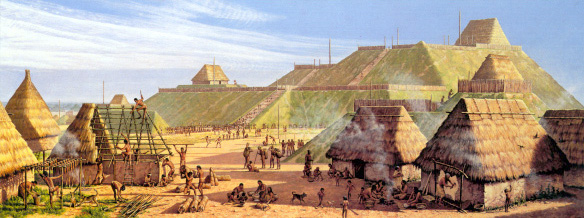
We are the Rigolet band of Pascagoula ChoctawOur vision is to achieve true sovereignty by attaining self-sufficiency. We will preserve and enhance our traditional values by living and teaching the inherent principles of respect, honor and integrity as embodied in our life-ways. We will utilize effective stewardship of our human, financial and natural resources. We will develop strong leadership through education, accountability, experience and positive reinforcement. |





|
|

In Southern Native American Indian spirituality above all and with nothing of more importance was the sacred fireThe sacred fire was diligently maintained throughout the year. The annual lighting of the new flame always occurred during the green corn ceremony. The green corn ceremony was a feast of thanksgiving to show gratitude for a successful corn crop, functions of the ceremony varied from tribe to tribe. Fire was the earthly representation of the sun, sustainer of all life and respect for the all-powerful deity who created the sun. Fire was never polluted with water; so fires were never extinguished with water except in funerary ceremonies an act that symbolized death. Repetition and formal correctness are defining characteristics of all societies in ceremony; the southern Indian was no exception. With knowledge that humans were creatures of error, as in all societies a source of redemption was necessary. In many societies sin is the faulting factor, in southern Indian society maintaining purity and avoiding pollution exemplified this. All social wrongs committed in the previous year was forgiven with the exception of murder. All suffering social restrictions could return as full social beings. Indeed the extinguishing of the old polluted fire and the lighting of the new brought redemption and a renewed social structure. Before the ending of the ceremony a man was sent to summon the women who came and stood outside the square meeting ground, the priest gave a speech to the warriors reminding them of their responsibilities to remain pure and carry their responsibilities bravely. Then in a much less polite language the priest gave a speech to the women, the told them if any had failed to extinguish the old fire or if any of them were impure they must depart immediately or that the divine fire would punish them and their relatives. He assumed a sharp tone in cautioning them not to break marital or sexual rules. He reminded them to endeavor in the coming year to stay pure else the divine fire would take vengeance on them. After this the priest ceremoniously lit the new fire , the women relit all fires in the homes and began cooking large quantities of new corn and vegetables for feast and celebration. |
| Symbols from our museum ceremonial collection | |||||
|
|
|
|
| ||
  The standard with the cross was an emblem of rank and importance. This is documented by both Rodrigo Rangel and the Gentleman of Elvas, chroniclers of the 1539-43 expedition of Hernando de Soto through the Southeast. Elvas describes "...a sort of fan of deerskin...the size of a shield, quartered with black and white, with a cross made in the middle...set on a small and very long staff...." Current thought is that the cross symbolizes the cardinal directions and the sacred fire, and the circle symbolizes the sun. It was also considered a symbol of the all-powerful Sun creator (a reflection of the creator of the sun), which would encompass the sacred fire in keeping the commandments of God. This as spoke by a Natchez chief explaining an appearance by God to the Natchez in their distant past. The cross in circle was one of the most sacred symbols of our ancient Grandparents It represents the Sun, Moon and fire. A truly sacred religious symbol to the Southern tribes was indeed this solar cross which was a symbol of both the sun and fire. It had several variations. TOQUA, A LATE MISSISSIPPIAN TOWN, circa AD 1450. Life-size mural by Greg Harlin. Mclung museum |


|
He is home with God, as I touched his still body one last time my mind knows I will see him again in a short time, although for now this does not make my pain go away or my grief less. I buried Mancho in his favorite spot, he will come to me when I call - come to me over the grim, dim frontier of death, and down the well-remembered path, and to my side again, for he belongs there by me. People may scoff me, who see no lightest blade of grass bent by his footfall, who hear no whimper, people who may never really have felt the love of a dog. I will smile at them, for I shall know something that is hidden from them,and which is well worth the knowing.The one best place to bury a loved dog is in the heart of his master and friend.11-28 - 05. My beloved friend Mancho a part of my heart goes with you.I now know the meaning of unconditional love Red Wolf |